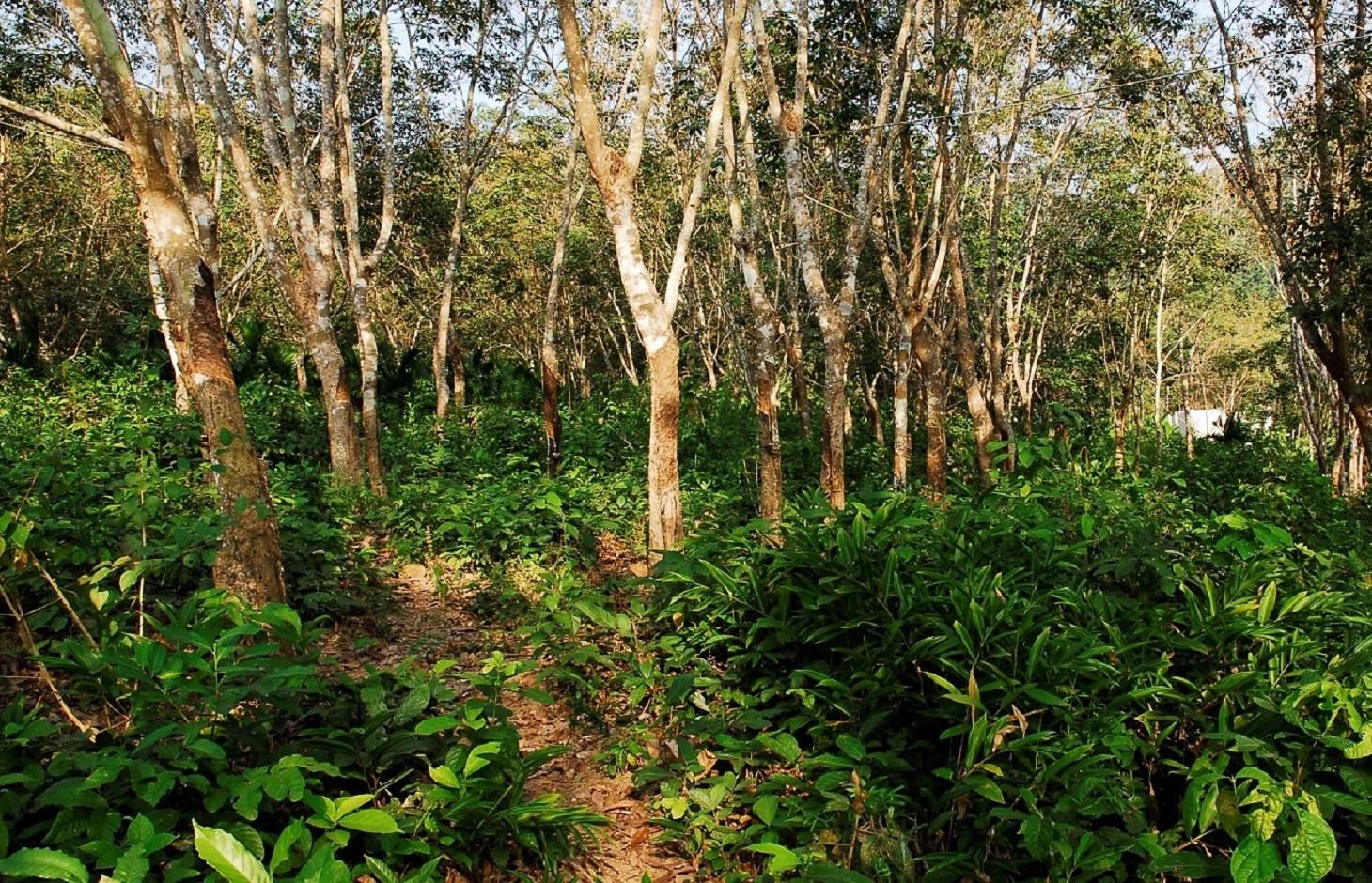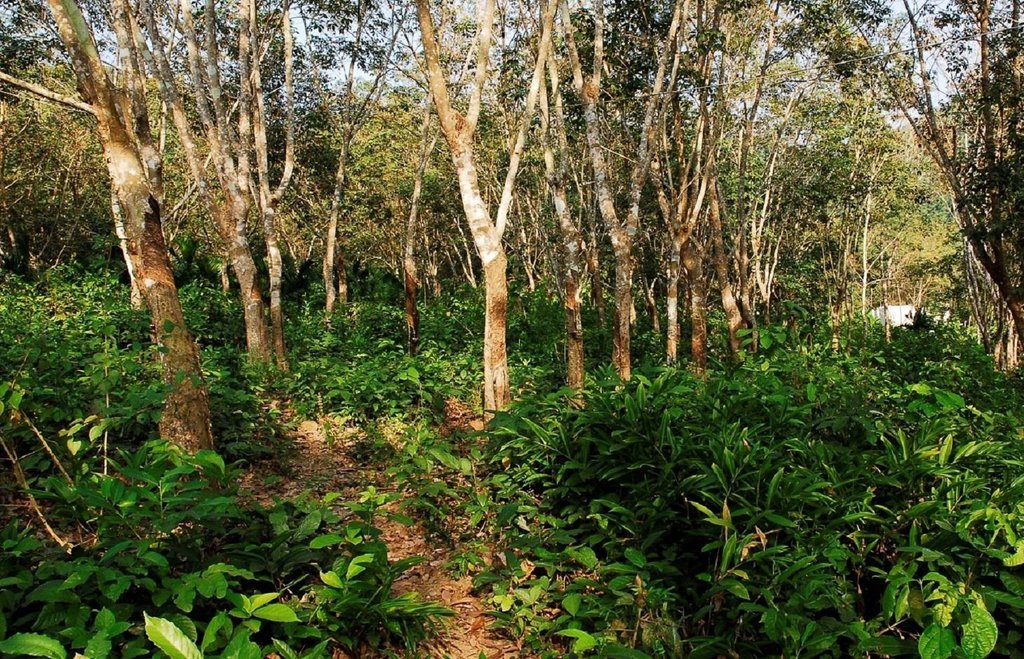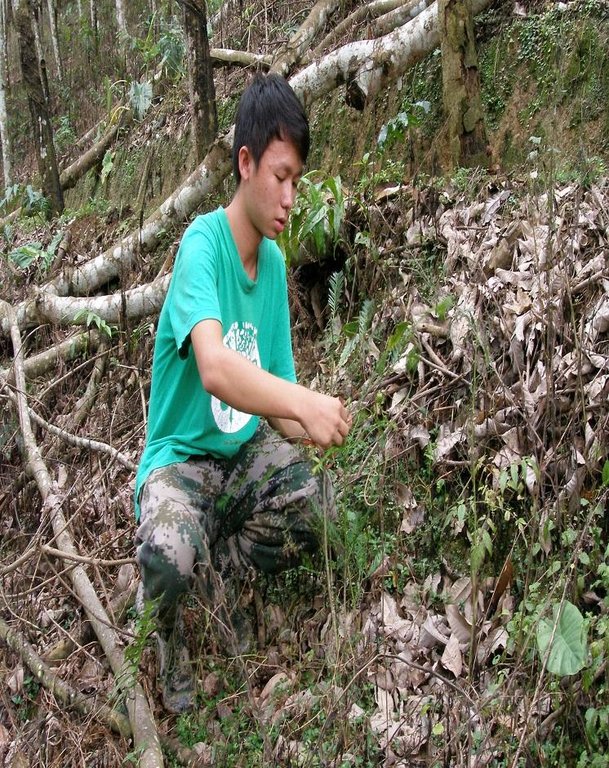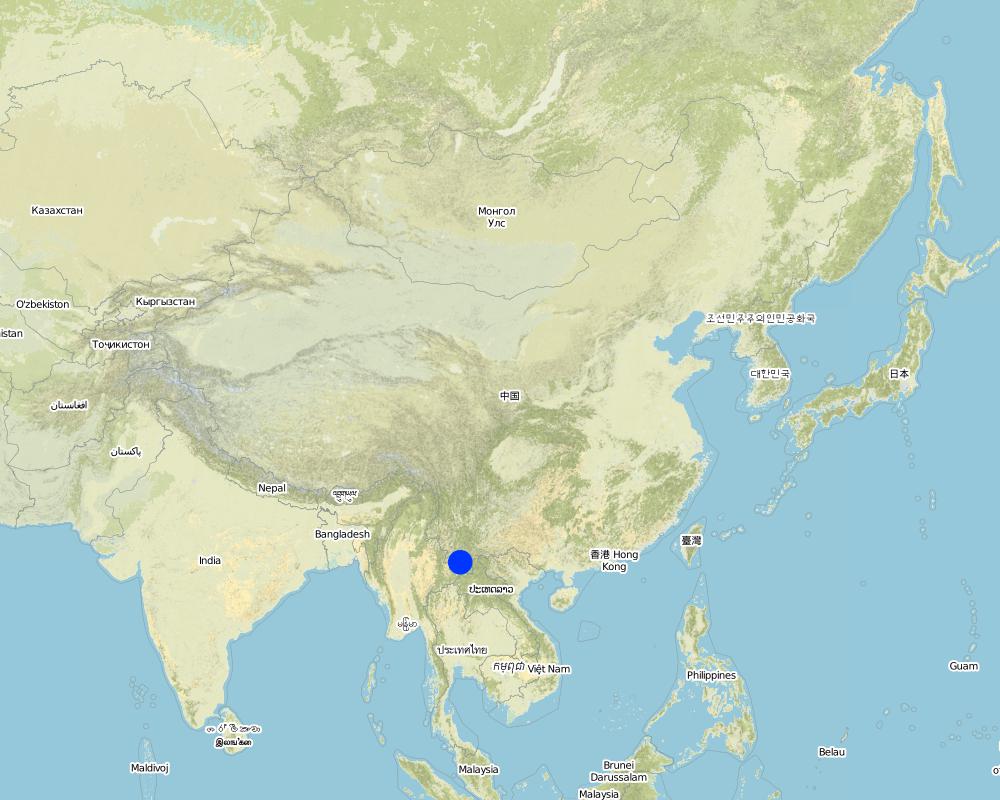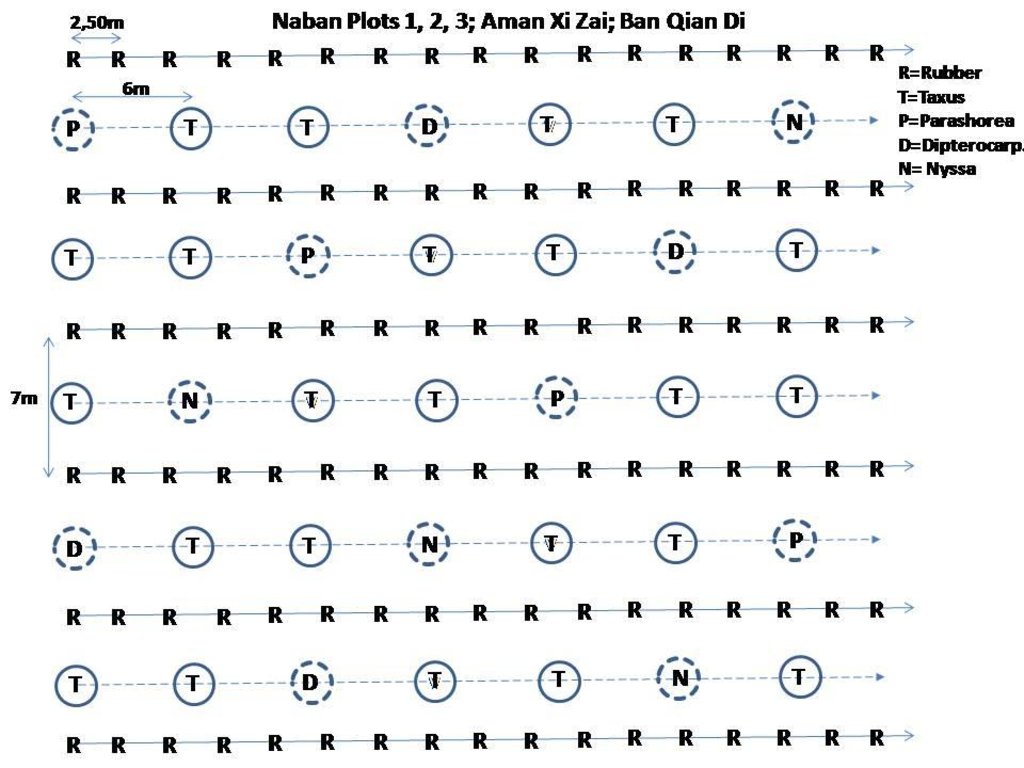Integrating native trees in rubber monocultures [Chine]
- Création :
- Mise à jour :
- Compilateur : Gerhard Langenberger
- Rédacteur : –
- Examinateurs : Deborah Niggli, Alexandra Gavilano
减缓单一橡胶种植的负面环境影响:关于橡胶与当地树种混种并结合杂草管理的生态种植研究 (Chinese)
technologies_1717 - Chine
Voir les sections
Développer tout Réduire tout1. Informations générales
1.2 Coordonnées des personnes-ressources et des institutions impliquées dans l'évaluation et la documentation de la Technologie
Spécialiste GDT:
Spécialiste GDT:
Blagodatsky Sergey
University of Hohenheim
Allemagne
Nom du projet qui a facilité la documentation/ l'évaluation de la Technologie (si pertinent)
Book project: Making sense of research for sustainable land management (GLUES)Nom du ou des institutions qui ont facilité la documentation/ l'évaluation de la Technologie (si pertinent)
Humboldt Universität zu Berlin (HU Berlin) - AllemagneNom du ou des institutions qui ont facilité la documentation/ l'évaluation de la Technologie (si pertinent)
Universität Hohenheim - AllemagneNom du ou des institutions qui ont facilité la documentation/ l'évaluation de la Technologie (si pertinent)
China Agricultural University (China Agricultural University) - Chine1.3 Conditions relatives à l'utilisation par WOCAT des données documentées
Le compilateur et la(les) personne(s) ressource(s) acceptent les conditions relatives à l'utilisation par WOCAT des données documentées:
Oui
1.4 Déclaration sur la durabilité de la Technologie décrite
Est-ce que la Technologie décrite ici pose problème par rapport à la dégradation des terres, de telle sorte qu'elle ne peut pas être déclarée comme étant une technologie de gestion durable des terres?
Non
2. Description de la Technologie de GDT
2.1 Courte description de la Technologie
Définition de la Technologie:
The technology combines the integration of native tree species into rubber monocultures with changed weed management to mitigate negative environmental impacts and to provide alternative income options for farmers.
2.2 Description détaillée de la Technologie
Description:
Natural rubber is a crucial renewable resource produced from the tree Hevea brasiliensis. Production is largely based on monoculture, often associated with chemical-based clean-weeding. This causes environmental problems such as loss of biodiversity, pesticide pollution and erosion of topsoil. The SLM-technology aims at mitigating negative impacts by interplanting the rubber with native tree species which have economic potential of their own. Changes in weed management are part of the package also.
Native (indigenous) tree species are integrated into mature rubber plantations. Criteria for species selection are: a) adapted to environmental conditions; b) shade tolerant; c) vertical growth not affected by light; d) conservation value; e) economic potential; f) easy to manage. Rubber trees are usually planted in rows at a spacing of 6-8 m, and an intra-row distance of 2.5 to 3 m. The native trees are planted between the rubber rows. The plantation should be mature as the canopy will have reached its highest density, and weed competition is naturally suppressed. The spacing of the native trees needs to be adapted to their growth potential and intended usage. After planting, regular monitoring is necessary to identify pests or diseases. The following species were selected for demonstration sites: 1) Parashorea chinensis, a valuable timber tree, 2) Taxus mairei, a multi-purpose tree, providing good timber but also an anti-cancer drug, taxol, and 3) Nyssa yunnanensis, selected for its conservation value. At the end of the economic life span of the rubber trees (about 30 years) there will be several options, but there are three main ones. First the rubber plantation can be replanted, although the harvest of the Parashorea chinensis trees would be premature. The Taxus mairei trees could be maintained through a new plantation cycle. Second, both, the rubber and the intercropped trees could be maintained for future timber and taxol production. Third, the plantation could be transformed into a sustainable forest managed scheme where the rubber trees are extracted step by step and the intercropped trees maintained for their intrinsic value.
Procedures for the selection and planting of the indigenous tree species are crucial. Identification should be based on suitability for the climate and soil as well as economic potential. The raising of tree seedlings requires experience and nursery propagation by experts might be required. Only healthy seedlings should be used. Planting should take place during rainy periods. Potted seedlings are better than bare-rooted seedlings since they establish better. Generally, weed management (if necessary) should shift from herbicide application to mechanical weeding. Grass competition needs to be avoided in any case! Controlled cover of natural undergrowth will reduce erosion and promote water infiltration.
The implementation site for the trials is located in Xishuangbanna Prefecture, Yunnan Province, SW China. The original vegetation was tropical rain and monsoon forest, but now there is a rich mosaic of different land-use and vegetation types. The whole region is exceptionally species rich and part of the Indo-Burma-Biodiversity Hotspot.
2.3 Photos de la Technologie
2.5 Pays/ région/ lieux où la Technologie a été appliquée et qui sont couverts par cette évaluation
Pays:
Chine
Région/ Etat/ Province:
Xishuangbanna Dai Autonomous Prefecture, Yunnan Province, PR China
Autres spécifications du lieu:
Naban River Watershed National Nature Reserve
Spécifiez la diffusion de la Technologie:
- répartie uniformément sur une zone
Si la Technologie est uniformément répartie sur une zone, précisez la superficie couverte (en km2):
0,03
Commentaires:
Total area covered by the SLM Technology is 0.03 km2.
The technology is currently tested on three trial sites coveríng 3 ha. Some farmers started to adopt and also planted trees in rubber. But no figures are available so far.
Map
×2.6 Date de mise en œuvre de la Technologie
Si l'année précise est inconnue, indiquez la date approximative: :
- il y a entre 10-50 ans
2.7 Introduction de la Technologie
- review on available knowledge on rubber management and history
Commentaires (type de projet, etc.) :
The technology is a result of the synthesis of research findings of the SURUMER-project and a review of available publications on rubber management.
3. Classification de la Technologie de GDT
3.1 Principal(aux) objectif(s) de la Technologie
- améliorer la production
- préserver l'écosystème
- conserver/ améliorer la biodiversité
3.2 Type(s) actuel(s) d'utilisation des terres, là où la Technologie est appliquée
Les divers types d'utilisation des terres au sein du même unité de terrain: :
Oui
Précisez l'utilisation mixte des terres (cultures/ pâturages/ arbres):
- Agroforesterie

Terres cultivées
- Plantations d’arbres ou de buissons
Plantations d'arbres et d'arbustes - Précisez les cultures:
- hévéa
Nombre de période de croissance par an: :
- 1
Précisez:
Longest growing period in days: 270, Longest growing period from month to month: April - December
Commentaires:
Major land use problems (compiler’s opinion): Large-scale expansion of rubber monocultures results in the loss of topsoil and siltation of streams with respective consequences for CO2 emissions (increased), soil degradation, water quality and stream ecology. The excessive application of agrochemicals adds to these problems. The monoculture practice combined with clean weeding results in plant biodiversity loss. The related simplification of habitat structures also leads to a considerable decline in animal biodiversity.
Major land use problems (land users’ perception): The focus of land users is primarily on sustainable income, and their environmental concerns mainly relate to water provisioning (land user's point of view). In the farmers view: “The biggest environmental problem is water quantity. Rubber sucks out a lot of water, therefore we do have a water scarcity problem”. Farmers are aware of the contamination of drinking water due to the use of pesticides and herbicides in the rubber plantations.
Future (final) land use (after implementation of SLM Technology): Mixed: Mf: Agroforestry
Type of cropping system and major crops comments: The majority of farmers shifted to pure rubber growing, although many villages still have paddy rice fields.
3.4 Approvisionnement en eau
Approvisionnement en eau des terres sur lesquelles est appliquée la Technologie:
- mixte: pluvial-irrigué
3.5 Groupe de GDT auquel appartient la Technologie
- agroforesterie
3.6 Mesures de GDT constituant la Technologie

pratiques végétales
- V1: Couverture d’arbres et d’arbustes

modes de gestion
- M2: Changement du niveau de gestion / d'intensification
3.7 Principaux types de dégradation des terres traités par la Technologie

érosion hydrique des sols
- Wt: perte de la couche superficielle des sols (couche arable)/ érosion de surface
- Wo: effets hors-site de la dégradation

dégradation physique des sols
- Pk: scellage et encroûtement

dégradation biologique
- Bc: réduction de la couverture végétale
- Bh: perte d’habitats
- Bs: baisse de la qualité et de la composition/ diversité des espèces

dégradation hydrique
- Hs: changement de la quantité d’eau de surface
- Hp: baisse de la qualité des eaux de surface
Commentaires:
Main causes of degradation: deforestation / removal of natural vegetation (incl. forest fires) (Replacement of forests by monocultures.), poverty / wealth (Older people still have the memory of extreme poverty. Rubber was the main driver to reduce poverty; high profit gained by rubber encouraged people in pursuit of large scale monoculture.), inputs and infrastructure: (roads, markets, distribution of water points, other, …) (A tremendously improved infrastructure allows the establishment of plantations even in previously remote areas.), governance / institutional (Strong support from government in terms of subsidy and other incentives from 1980s to 2000s; subsidies are more recently reduced)
Secondary causes of degradation: crop management (annual, perennial, tree/shrub) (Clear-weeding, mainly with herbicides.), disturbance of water cycle (infiltration / runoff) (Removal of natural vegetation leads to higher runoff), land tenure (Introduction of Household Responsibility System in 1980s gave use-right to farmers. This pushed decisions on transformating natural forests to monocultures. No full property rights could hinder could), labour availability (Compared to the traditional agricultural system, rubber monocultures require less labour. Recently, there is even less labour available due to the relatively low income gained by rubber), education, access to knowledge and support services (The awareness about ecosystem services and functions is still poorly developed.), war and conflicts (Chinese government´s objective to be independent on important strategic resources such as rubber)
3.8 Prévention, réduction de la dégradation ou réhabilitation des terres dégradées
Spécifiez l'objectif de la Technologie au regard de la dégradation des terres:
- réduire la dégradation des terres
- restaurer/ réhabiliter des terres sévèrement dégradées
4. Spécifications techniques, activités, intrants et coûts de mise en œuvre
4.1 Dessin technique de la Technologie
Spécifications techniques (associées au dessin technique):
The concept is based on the commonly suggested planting scheme of rubber with a row distance of ca. 7 m and a spacing of trees within the rows of ca. 2.5 to 3 m, resulting in ca. 450 to 500 trees/ha. The intercropping will take place between the rubber rows, on terraced slopes between the rubber terraces. Planting takes place after the plantations have reached half of their economic life span, which is ca. 15 years. It is important to consider that farmers often plant much denser than suggested by official guidelines, which needs an assessment of the light / shade conditions. With a too high rubber density the resulting light conditions might be too poor for intercropping even for forest trees. In our case the distance within a row of the intercropped trees has been set at 6 m, due to the (known) ecological characteristics of the selected 4 tree species. But the decision needs to be taken specifically for each new site, the potential tree species and the intentions of the land-user. Thus, in our case, we opted for a higher density of Taxus (bold circles) which is well known for its slow growth. and integrated the two other tree species at a wider distance (dotted circles).
Location: Yunnan Province, SW China. Xishuangbanna Prefecture
Date: September 2014
Technical knowledge required for field staff / advisors: high (The selection and management of native tree species requires a very good ecological as well as dendrological knowledge and understanding.)
Technical knowledge required for land users: moderate (If species selection has been successful and management is supported by a knowledgeable extension service.)
Main technical functions: control of dispersed runoff: retain / trap, stabilisation of soil (eg by tree roots against land slides), increase in organic matter, increase of infiltration, promotion of vegetation species and varieties (quality, eg palatable fodder)
Secondary technical functions: control of raindrop splash, improvement of surface structure (crusting, sealing), improvement of topsoil structure (compaction), increase / maintain water stored in soil, increase of groundwater level / recharge of groundwater
Aligned: -contour
Vegetative material: T : trees / shrubs
Vegetative measure: Intercropping of native tree species
Vegetative material: T : trees / shrubs
Number of plants per (ha): 240
Spacing between rows / strips / blocks (m): 7 m
Vertical interval within rows / strips / blocks (m): 6 m
Vegetative measure: Vegetative material: T : trees / shrubs
Trees/ shrubs species: Parashorea chinensis, Taxus mairei, Nyssa yunnanensis: all planted (container-planting)
Slope (which determines the spacing indicated above): 0-80%
Gradient along the rows / strips: 0%
Change of land use practices / intensity level: Shift from herbicide-based weed management to mechanical weeding with machine tools. This has not yet been implemented due lack of experience and proper tools.
Auteur:
G. Langenberger, Institute of Agricultural Sciences in the Tropics (490), University of Hohenheim, Germany
4.2 Informations générales sur le calcul des intrants et des coûts
autre/ monnaie nationale (précisez):
RMB
Indiquez le taux de change des USD en devise locale, le cas échéant (p.ex. 1 USD = 79.9 réal brésilien): 1 USD = :
6,3
Indiquez le coût salarial moyen de la main d'œuvre par jour:
16.00
4.3 Activités de mise en place/ d'établissement
| Activité | Calendrier des activités (saisonnier) | |
|---|---|---|
| 1. | 1.Seedling acquisition and transport | before or during rainy season |
| 2. | 2.Planting of seedlings in rainy season | rainy season |
| 3. | Weed management with brush cutters. | ? no experience |
4.4 Coûts et intrants nécessaires à la mise en place
| Spécifiez les intrants | Unité | Quantité | Coûts par unité | Coût total par intrant | % du coût supporté par les exploitants des terres | |
|---|---|---|---|---|---|---|
| Main d'œuvre | labour | ha | 1,0 | 80,0 | 80,0 | 100,0 |
| Equipements | machine use | ha | 1,0 | 80,0 | 80,0 | |
| Equipements | animal traction | ha | 1,0 | 8,0 | 8,0 | 100,0 |
| Matériel végétal | seedlings | ha | 1,0 | 2400,0 | 2400,0 | |
| Coût total de mise en place de la Technologie | 2568,0 | |||||
| Coût total de mise en place de la Technologie en dollars américains (USD) | 407,62 | |||||
Commentaires:
Duration of establishment phase: 0.07 month(s)
4.5 Activités d'entretien/ récurrentes
| Activité | Calendrier/ fréquence | |
|---|---|---|
| 1. | 1.Control of pests and diseases | monthly |
4.6 Coûts et intrants nécessaires aux activités d'entretien/ récurrentes (par an)
| Spécifiez les intrants | Unité | Quantité | Coûts par unité | Coût total par intrant | % du coût supporté par les exploitants des terres | |
|---|---|---|---|---|---|---|
| Main d'œuvre | labour | ha | 1,0 | 96,0 | 96,0 | 100,0 |
| Coût total d'entretien de la Technologie | 96,0 | |||||
| Coût total d'entretien de la Technologie en dollars américains (USD) | 15,24 | |||||
Commentaires:
The costs are based on the establishment of 3 demonstration plots of ca. 1 ha each. It should be possible to considerably reduce the costs by producing seedlings on site.
4.7 Facteurs les plus importants affectant les coûts
Décrivez les facteurs les plus importants affectant les coûts :
Seedling costs are by far the major cost factor. Since the selected species are very unusual and don't have a considerable market they were extremely expensive. Since Taxus is also a reputed medicinal plant, it might also have influenced the price. All other costs are actually negligible compared to the costs of the seedlings. In this case the establishment of an own nursery might considerably reduce the costs, since propagation at least of Taxus and Parashorea is easy if the seeds can be acquired.
5. Environnement naturel et humain
5.1 Climat
Précipitations annuelles
- < 250 mm
- 251-500 mm
- 501-750 mm
- 751-1000 mm
- 1001-1500 mm
- 1501-2000 mm
- 2001-3000 mm
- 3001-4000 mm
- > 4000 mm
Zone agro-climatique
- subhumide
Thermal climate class: subtropics
5.2 Topographie
Pentes moyennes:
- plat (0-2 %)
- faible (3-5%)
- modéré (6-10%)
- onduleux (11-15%)
- vallonné (16-30%)
- raide (31-60%)
- très raide (>60%)
Reliefs:
- plateaux/ plaines
- crêtes
- flancs/ pentes de montagne
- flancs/ pentes de colline
- piémonts/ glacis (bas de pente)
- fonds de vallée/bas-fonds
Zones altitudinales:
- 0-100 m
- 101-500 m
- 501-1000 m
- 1001-1500 m
- 1501-2000 m
- 2001-2500 m
- 2501-3000 m
- 3001-4000 m
- > 4000 m
5.3 Sols
Profondeur moyenne du sol:
- très superficiel (0-20 cm)
- superficiel (21-50 cm)
- modérément profond (51-80 cm)
- profond (81-120 cm)
- très profond (>120 cm)
Texture du sol (de la couche arable):
- moyen (limoneux)
- fin/ lourd (argile)
Matière organique de la couche arable:
- moyen (1-3%)
5.4 Disponibilité et qualité de l'eau
Disponibilité de l’eau de surface:
bonne
Qualité de l’eau (non traitée):
faiblement potable (traitement nécessaire)
5.5 Biodiversité
Diversité des espèces:
- élevé
5.6 Caractéristiques des exploitants des terres appliquant la Technologie
Orientation du système de production:
- commercial/ de marché
Revenus hors exploitation:
- 10-50% de tous les revenus
Niveau relatif de richesse:
- pauvre
- moyen
Individus ou groupes:
- individu/ ménage
Niveau de mécanisation:
- travail manuel
Genre:
- hommes
Indiquez toute autre caractéristique pertinente des exploitants des terres:
Land users applying the Technology are mainly Leaders / privileged
Difference in the involvement of women and men: So far, the number of persons applying the technology is still too low to draw any meaningful conclusion.
Population density: 10-50 persons/km2
Annual population growth: < 0.5% (farmers have been well off in the past, currently they are under pressure due to the very low rubber).
5.7 Superficie moyenne des terres utilisées par les exploitants des terres appliquant la Technologie
- < 0,5 ha
- 0,5-1 ha
- 1-2 ha
- 2-5 ha
- 5-15 ha
- 15-50 ha
- 50-100 ha
- 100-500 ha
- 500-1 000 ha
- 1 000-10 000 ha
- > 10 000 ha
Cette superficie est-elle considérée comme de petite, moyenne ou grande dimension (en se référant au contexte local)?
- petite dimension
5.8 Propriété foncière, droits d’utilisation des terres et de l'eau
Propriété foncière:
- état
Droits d’utilisation des terres:
- individuel
Commentaires:
Water use rights seem to be an issue.
5.9 Accès aux services et aux infrastructures
santé:
- pauvre
- modéré
- bonne
éducation:
- pauvre
- modéré
- bonne
assistance technique:
- pauvre
- modéré
- bonne
emploi (par ex. hors exploitation):
- pauvre
- modéré
- bonne
marchés:
- pauvre
- modéré
- bonne
énergie:
- pauvre
- modéré
- bonne
routes et transports:
- pauvre
- modéré
- bonne
eau potable et assainissement:
- pauvre
- modéré
- bonne
6. Impacts et conclusions
6.1 Impacts sur site que la Technologie a montrés
Impacts socio-économiques
Production
production de bois
Commentaires/ spécifiez:
considerably, but no experience
Revenus et coûts
charge de travail
Commentaires/ spécifiez:
no practical experience, yet
Impacts socioculturels
apaisement des conflits
Impacts écologiques
Cycle de l'eau/ ruissellement
qualité de l'eau
Commentaires/ spécifiez:
less erosion
ruissellement de surface
Commentaires/ spécifiez:
cf. Hongxi
Sols
couverture du sol
Commentaires/ spécifiez:
compared to clear-weeding
Biodiversité: végétale, animale
biomasse/ au dessus du sol C
Commentaires/ spécifiez:
cf. Xueqing
6.2 Impacts hors site que la Technologie a montrés
envasement en aval
pollution des rivières/ nappes phréatiques
capacité tampon/de filtration
6.3 Exposition et sensibilité de la Technologie aux changements progressifs et aux évènements extrêmes/catastrophes liés au climat (telles que perçues par les exploitants des terres)
Changements climatiques progressifs
Changements climatiques progressifs
| Saison | Augmentation ou diminution | Comment la Technologie fait-elle face à cela? | |
|---|---|---|---|
| températures annuelles | augmente | bien |
Extrêmes climatiques (catastrophes)
Catastrophes météorologiques
| Comment la Technologie fait-elle face à cela? | |
|---|---|
| pluie torrentielle locale | bien |
| tempête de vent locale | pas connu |
Catastrophes climatiques
| Comment la Technologie fait-elle face à cela? | |
|---|---|
| sécheresse | pas bien |
Catastrophes hydrologiques
| Comment la Technologie fait-elle face à cela? | |
|---|---|
| inondation générale (rivière) | pas connu |
Autres conséquences liées au climat
Autres conséquences liées au climat
| Comment la Technologie fait-elle face à cela? | |
|---|---|
| réduction de la période de croissance | pas bien |
| cold spells | pas bien |
Commentaires:
The above assessment is based on the fact that we are actually dealing with plants adapted to tropical conditions. Therefore, the species should be less affected by high temperatures and increasing rainfall, but might be sensitive to droughts. Nevertheless, there is no experience!
6.4 Analyse coûts-bénéfices
Quels sont les bénéfices comparativement aux coûts de mise en place (du point de vue des exploitants des terres)?
Rentabilité à court terme:
négative
Rentabilité à long terme:
positive
Quels sont les bénéfices comparativement aux coûts d'entretien récurrents (du point de vue des exploitants des terres)?
Rentabilité à court terme:
positive
Rentabilité à long terme:
très positive
Commentaires:
The establishment costs for the demo-sites have been very high, but could be considerably reduced if adopted by more farmers. The assessment above therefore needs verification!
6.5 Adoption de la Technologie
Commentaires:
100% of land user families have adopted the Technology with external material support
3 land user families have adopted the Technology with external material support
There is a little trend towards spontaneous adoption of the Technology. Comments on adoption trend: We experienced interest in the technology by farmers, but due to the lack of experience and the lack of affordable and accessible seedlings they are hesitant.
6.7 Points forts/ avantages/ possibilités de la Technologie
| Points forts/ avantages/ possibilités du point de vue de l'exploitant des terres |
|---|
| Additional income options. |
| Points forts/ avantages/ possibilités du point de vue du compilateur ou d'une autre personne ressource clé |
|---|
| The technology offers considerable long-term advantageous to farmers. It diversifies the product portfolio and good options for additional income in the future. Beyond the establishment it doesn't require much labour. |
6.8 Faiblesses/ inconvénients/ risques de la Technologie et moyens de les surmonter
| Faiblesses/ inconvénients/ risques du point de vue de l’exploitant des terres | Comment peuvent-ils être surmontés? |
|---|---|
| High investment costs. | Government subsidies. |
| Time until first returns can be expected. 5-10 years for taxol production |
| Faiblesses/ inconvénients/ risques du point de vue du compilateur ou d'une autre personne ressource clé | Comment peuvent-ils être surmontés? |
|---|---|
| The technology is based on a long-term perspective and thus favours farmers who have a such an outlook. But farmers with little land usually think short-term. | The current trend of rural-urban migration will support the technology since it can be easily combined with off-farm work. According to SURUMER findings off-farm income already contributes about one third of the overall household income in the rubber growing areas. |
| Current establishment costs are very high due to the lack of a seedling market. | If the technology becomes known and popular, more nurseries will produce seedlings which will reduce costs. Alternatively, farmers might establish their individual (or community) nurseries. |
| The technology requires considerable knowledge about tree ecology and tree breeding. | There should be extension officers at the local agricultural or forestry bureaus supporting farmers. |
7. Références et liens
7.1 Méthodes/ sources d'information
- visites de terrain, enquêtes sur le terrain
- interviews/entretiens avec les exploitants des terres
Quand les données ont-elles été compilées (sur le terrain)?
12/02/2016
7.2 Références des publications disponibles
Titre, auteur, année, ISBN:
Ahrends, A. et al. (2015) Current trends of rubber plantation expansion may threaten biodiversity and livelihoods
Disponible à partir d'où? Coût?
Global Environ Change, 34, 48-58.
Titre, auteur, année, ISBN:
Langenberger, G. et al. (2016) Rubber intercropping: a viable concept for the 21st century?
Disponible à partir d'où? Coût?
Agrofor Syst, 1-20.
Titre, auteur, année, ISBN:
Liu, H. et al. (2016) Impact of herbicide application on soil erosion and induced carbon loss in a rubber plantation of Southwest China
Disponible à partir d'où? Coût?
CATENA, 145, 180-192.
Liens et modules
Développer tout Réduire toutLiens
Aucun lien
Modules
Aucun module trouvé


